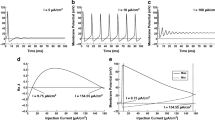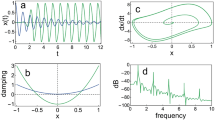Abstract
Multichannel mapping of electrical field on heart ventricle epicardium and the body surface in frogs Rana esculenta and Rana temporaria was performed at periods of the ventricular myocardium depolarization and repolarization. The zone of the epicardium early depolarization is located on epicardium of the ventricle base posterior wall, while the late depolarization zone—on its apex and on the base anterior wall. The total vector of sequence of the ventricle epicardium depolarization is directed from the base to the apex. The zone of the early repolarization is located in the apical area, while that of the late one—in the area of the base. On the frog body surface the cardioelectric field with the cranial zone of negative and the caudal zone of positive potentials is formed before the appearance of the QRS complex on ECG. At the period of the heart ventricle repolarization the zone of the cardioelectric field negative potentials is located in the cranial, while that of the positive ones—in the body surface caudal parts. The cardioelectric field on the frog body surface at the periods of depolarization and repolarization of the ventricle myocardium reflects adequately the projection of sequence of involvement with excitation and of distribution of potentials on epicardium.
Similar content being viewed by others
References
Shmakov, D.N. and Roshchevsky, M.P., Formation of Cardioelectric Fields Potentials on the Heart and Body Surface of Vertebrate Animals, Fiziol. Zh. SSSR, 1995, vol. 81, pp. 51–58.
Boineau, J.P., Spach, M.S., Pilkington, T.C, and Barr, R.C., Relationship between Body Surface Potential and Ventricular Excitation in the Dog, Circ. Rec., 1966, vol. 19, pp. 498–495.
Ramsey, M., Barr, R.C., and Spach, M.S., Comparison of Measured Torso Potentials with those Simulated from Epicardial Potentials for Ventricular Depolarization and Repolarization in the intact Dog, Circ. Res., 1977, vol. 41, pp. 660–672.
Roshchevsky, M.P., Shmakov, D.N., Roshchevskaya, I.M., et al., Formation of Cardiolectric Field on Ventricular Epicardium and Body Surface in Animals with Different Myocardium Activation Patterns, Med. Biol. Eng. Comp., 1996, vol. 34, N 1, pp. 105–106.
Vityazev, V.A., Kharin, S.N., Azarov, Ya.E., et al., Comparison by Time of the Initial Moments of Ventricular Myocardium Activation and Cardioelectric Field Parameters on the Dog Body Surface, Byull. Exper. Biol. Med., 2001, vol. 131, pp. 388–391.
Kharin, S.N., Shamkov, D.N., Antonova, N.A., et al., Formation of the Cardioelectric Field on the Body Surface at the Period of Ventricular Myocardium Activation in the Hen Gallus domesticus, Zh. Evol. Biokhim. Fiziol., 2001, vol. 37, pp. 121–127.
Udel’nov, M.G., Fiziologiya serdtza (Heart Physiology), Moscow, 1975.
Shmakov, D.N. and Abrosimova, G.V., Depolarization Process of Heart Ventricle and Formation of Electrocardiographic Complex QRS in Frog, Sechenov Ross. Fiziol. Zh., 1989, vol. 75, pp. 1116–1120.
Terentiev, P.V., Lyagushka (Frog), Moscow, 1950.
Roshchevsky, M.P., Evolyutsionnaya elektrokardiologiya (Evolutionary Electrocardiology), Leningrad, 1972.
Sedmera, D., Reckova, M., DeAlmeida, A., et al., Functional and Morphological Evidence for a Ventricular Conduction System in Zebrafish and Xenopus Hearts, Am. J. Physiol., Heart Circ. Physiol., 2003, vol. 284, pp. 1152–1160.
Millar, C.K., Kralios, F.A., and Lux, R.L., Correlation between Refractory Periods and Activation—Recovery Intervals from Electrograms: Effects of Rate and Adrenergic Interventions, Circulation, 1985, vol. 72, pp. 1372–1379.
Steinhaus, B.M., Estimating Cardiac Transmembrane Activation and Recovery Times from Unipolar Bipolar Extracellular Electrograms: A Simulation Study, Circ. Res., 1989, vol. 64, pp. 449–462.
Shmakov, D.N., Correlation of Form of Extracellular Epicardium Potentials with Excitation Sequence of Myocardium Intramural Layers in Vertebrates, Zh. Evol. Biokhim. Fiziol., 1984, vol. 20, pp. 112–113.
Roshchevsky, M.P., Shmakov, D.N., and Kraft, A.V., Initial Ventricular Activity in Superficial Cardiolectric Fields of Reptilians, Birds, and Mammals, Fiziologiya i biokhimiya zhivotnykh: Tr. Komi Fil. AN SSSR (Animal Physiology and Biochemistry: Proc. Komi Dept. USSR AS), Syktyvkar, 1974, no. 27, pp. 3–9.
Shmakov, D.N. and Roshchevsky, M.P., Chronotopography of Heart Ventricle Excitation in Bony Fish, Zh. Evol. Biokhim. Fiziol., 1982, vol. 18, pp. 53–58.
Azarov, Ya.E., Roshchevsky, M.P., Shmakov, D.N., Vityazev, V.A., Roshchevskaya, I.M., and Arteeva, N.V., Effect of Hypothermia on the Repolarization Sequence in the Rabbit Ventricular Epicardium, Sechenov Ross. Fiziol. Zh., 2001, vol. 87, pp. 1309–1317.
Shmakov, D.N., Roshchevsky, M.P., Vityazev, V.A., et al., Cardioelectric Field on the Epicardial and Body Surfaces in Animals with Different Myocardium Activation Patterns during the T Wave Period, Building Bridges in Electrocardiology: Proc. XXIInd Intern. Congr. on Electrocardiology, van Oosterom, A., Oostendorp, T.F., and Uijen, G.J.H., Eds., Nijmegen, Univ. Press Nijmegen, 1995, pp. 84–85.
Lacroix, D., Extramiana, F., Delfaut, P., Adamantidis, M., Grandmougin, D., Klug, D., Kaset, S., and Dupuis, B., Factors Affecting Epicardial Dispersion of Repolarization: Mapping Study in the Isolated Porcine Heart, Cardiovasc. Res., 1999, vol. 41, pp. 563–574.
Azarov, J.E., Shmakov, D.N., Vityazev, V.A., et al., Activation and Repolarization Patterns in the Ventricular Epicardium under Sinus Rhythm in Frog and Rabbit Hearts, Comp. Biochem. Physiol., 2007, vol. A146, pp. 310–316.
Spach, M.S. and Barr, R.C., Ventricular Intramural and Epicardial Potential Distributions during Ventricular Activation and Repolarization in the Intact Dog, Circ. Res., 1975, vol. 37, pp. 243–257.
Author information
Authors and Affiliations
Additional information
Original Russian Text © M.A. Vaikshnoraite, A.S. Belogolova, V.A. Vityazev, Ya.E. Azarov, D.N. Shmakov, 2008, published in Zhurnal Evolyutsionnoi Biokhimii i Fiziologii, 2008, Vol. 44, No. 2, pp. 173–179.
Rights and permissions
About this article
Cite this article
Vaikshnoraite, M.A., Belogolova, A.S., Vityazev, V.A. et al. Cardiac electric field at the period of depolarization and repolarization of the frog heart ventricle. J Evol Biochem Phys 44, 204–211 (2008). https://doi.org/10.1134/S0022093008020084
Received:
Published:
Issue Date:
DOI: https://doi.org/10.1134/S0022093008020084




